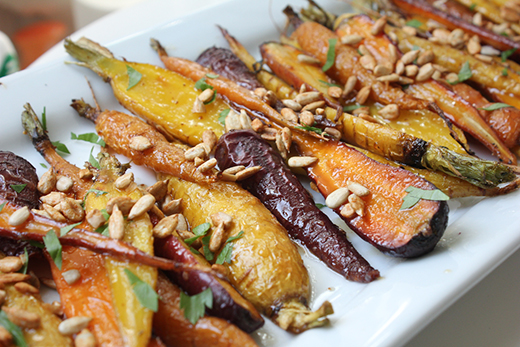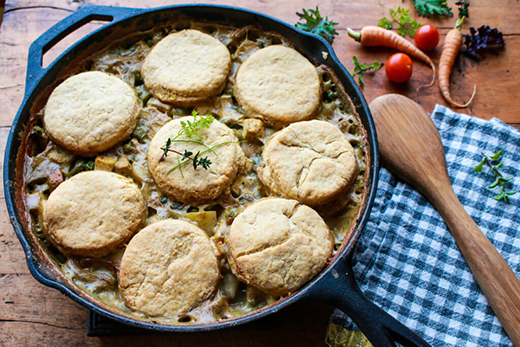By Michael Serrur
The holiday season is a joyous time of year for clients, but it’s also a challenging one, especially when they’re trying to maintain healthful habits and behaviors. Typical celebrations tend to include much food, sweets, and drinks, and fewer opportunities for physical activity and self-care.
But with some preparation and planning, clients can avoid the common obstacles that may have derailed their efforts in the past, whether they’re hosting a family affair or attending get-togethers as guests. And they don’t have to wait for the holidays to start; they can begin putting them into practice now.
Today’s Dietitian speaks with Jill Weisenberger, MS, RDN, CDCES, CHWC, FAND, author of Prediabetes: A Complete Guide, and Karen Collins, MS, RDN, CDN, FAND, nutrition advisor to the American Institute for Cancer Research and founder of Taking Nutrition from Daunting to Doable, to create a family-friendly list of practical cooking, eating, and entertaining tips to help clients successfully navigate the holiday table with their health goals intact.
Weisenberger and Collins agree clients should do the following:
Add Vegetables to Everything
Tell clients to always add more vegetables whenever possible, Weisenberger says. “If a recipe calls for three carrots, use five.” And don’t be afraid to modify dishes by dropping in a few extra veggies. It’s easy to add more vegetables to dishes such as stuffing, soup, stew, rice, or even macaroni and cheese. Clients can boost the vegetable content of any starchy side dish they can think of. For people with CVD or diabetes, sending blood sugar or blood pressure beyond safe levels can be a problem, so making healthful, more vegetable-forward recipes can help them enjoy holiday traditions without putting their health at risk.
Focus on Fruit for Low-Fat, Low-Sugar Desserts
“Focusing on fruit and other low-fat ingredients is a healthful way to end the meal with a sweet, satisfying treat,” Collins says. “Fruit parfaits with layers of fruit alternating with layers of plain or lower-sugar lemon yogurt, baked pear or apple with nuts and a dollop of yogurt, and ‘nice cream’ (blended frozen bananas and other fruit) are all excellent low-fat dessert options,” she says.
Don’t Fear Favorite Holiday Foods
Whether clients have diabetes or are watching what they eat, they don’t need to avoid all of their favorite holiday foods. The key is portion control and thoughtful choices. “Everyone has to make decisions during the holiday season when it comes to the dinner table,” Weisenberger says, but focusing on festive, celebratory foods (eg, gingerbread, eggnog, latkes) can help provide the most satisfaction.
Modernize the ‘Charcuterie’ Board
Clients who like to make charcuterie boards don’t have to be “confined to sausages and other processed meats and cheeses,” Collins says. Suggest they “make plant-based foods at least two-thirds of the board by including vegetables, fresh fruit, dried fruit, and nuts.” Recommend clients keep things interesting by serving some innovative homemade dips along with their platters. For example, start with a base of plain, low-fat Greek yogurt, hummus, avocado, or puréed beans, and then dress it up with some extra seasonings, fresh herbs, spices, or condiments like a spicy mustard or chili paste.
Stick to Normal Eating Patterns
Clients may find themselves enamored with all the festive foods served, but encourage them to stick to their usual eating pattern whenever possible. “The plate method of meal planning works very well for a buffet,” Weisenberger says. “Fill half your plate with nonstarchy vegetables, one-quarter of your plate with protein-rich foods, and the remaining one-quarter of your plate with starchy foods.”
Build Around Beans
Beans are a great source of fiber and plant-based protein, and they easily can play the role of meat in dishes like shepherd’s pie, pot pie, and stuffed peppers. Try adding them to salads, soups, and vegetable dishes, or serve them as an appetizer, such as roasted chickpeas or steamed edamame. Both Collins and Weisenberger advocate for more beans, but they agree that it’s important for clients to look at sodium levels and try to purchase canned beans that are low in sodium.
Drink from Smaller Wine Glasses
Overdoing it with wine, beer, and spirits is common during the holiday season. To avoid this, Collins recommends clients use smaller wine glasses. “Many wine glasses today can include two or three ‘servings’ of wine when filled,” she says. “People often don’t realize that the big glasses were designed to include lots of air space for sniffing.” It’s also wise for clients to have a pitcher of water filled with sliced citrus fruits or fresh herbs in close proximity to where the alcoholic beverages are being served.
These tips will enable people to enjoy all the delicious, celebratory foods that are so important to the holidays without having to feel guilty or stressed. And by implementing them at the tail end of the year, clients are already on their way to a more healthful 2022. Remember to tell them that if they slip up or overdo it, they always can recommit to their more healthful intentions the next day.
Dietitians can share the following two recipes with clients to kick off delicious healthful holiday eating.
— Michael Serrur is the head writer and editor at The Monday Campaigns, a nonprofit public health initiative focused on healthful living. Serrur’s articles about food, restaurants, and healthful eating have been featured in major digital publications, including MSN, Yahoo, Fox News, The Daily Meal, Food Business News, and The LA Times.
Recipes

Roasted Rainbow Carrots With Maple Mustard Glaze
Serves 4
Ingredients
1 lb rainbow carrots, scrubbed, trimmed, and halved lengthwise
1 tsp olive oil
1/4 tsp salt
1/2 T butter
2 tsp maple syrup
1 T Dijon mustard
2 T toasted sunflower seeds
Chopped parsley for garnish
Directions
1. Preheat oven to 475° F.
2. In a shallow baking dish, toss the carrots with oil and salt to coat. Roast in the oven for 10 minutes.
3. Heat the butter in a small saucepan until golden brown, remove from heat and add the maple syrup and mustard. Drizzle over the carrots and shake pan to coat. Return to the oven and continue to roast for another 8 minutes, or until brown and tender.
4. Arrange the carrots on a serving plate and top with sunflower seeds and parsley. Serve immediately.
Nutrient Analysis per serving
Calories: 86; Total fat: 4 g; Sat fat: 1 g; Sodium: 236 mg; Total carbohydrate: 13 g; Dietary fiber: 3 g; Sugars: 7 g
— Source: Recipe and photo courtesy of The Monday Campaigns, a nonprofit public health initiative that promotes sustainable behavior change by dedicating every Monday to healthful habits.

Vegetable Pot Pie With Whole Wheat Biscuit Topping
Serves 8
Ingredients
Vegetable Filling
1 T olive oil
1 medium onion, diced
3 medium carrots, sliced
3 celery stalks, sliced
1 potato, peeled and diced
2 cloves garlic, finely diced
1 15-oz package extra firm tofu, drained
1 1/2 cups frozen peas
3 T fresh parsley, chopped
3 T all-purpose flour
2 tsp marjoram
1/2 tsp ground mustard
1/2 tsp celery salt
1/2 tsp black pepper
Sea salt (to taste, optional)
1 1/2 cups vegetable broth
1 1/2 cups plant-based milk, plain, unsweetened (eg, soy or almond)
Whole Wheat Biscuits
1 cup white whole wheat flour
1 cup all-purpose flour
1 T baking powder
1/2 cup soft vegan margarine
3/4 cup plant-based milk
Directions
To make vegetable filling:
1. Heat olive oil in a large (about 12 inches) cast iron skillet or sauté pan, and sauté onions, carrots, celery, potatoes, and garlic for 8 minutes.
2. Add tofu, peas, and parsley, and sauté for an additional 2 minutes.
3. Add flour, marjoram, mustard, celery salt, black pepper, and sea salt (optional) and stir to coat vegetables.
4. Add broth and plant-based milk.
5. Stir well, cover, and continue to cook over medium heat until bubbly and thick—about 5 minutes.
6. Remove from heat.
To make whole wheat biscuits:
1. Preheat oven to 350° F.
2. Place flours and baking powder in a medium mixing bowl, and stir well.
3. Cut in margarine with a fork until crumbly. Add plant-based milk and stir to combine well, without over-stirring.
4. Place biscuit dough on a floured surface and roll out to about 1 inch thick. Cut out with 2-inch biscuit cutter or a 2-inch glass to make 8 biscuits.
5. Place biscuits evenly on the surface of the vegetable pot pie in skillet or sauté pan.
6. Place in the center of the oven and bake until biscuits are golden brown and firm, about 20 to 25 minutes.
7. Serve in a cast iron skillet.
Nutrient Analysis per serving
Calories: 364; Total fat: 13 g; Sat fat: 3 g; Sodium: 333 mg; Total carbohydrate: 49 g; Dietary fiber: 6 g; Sugars: 4 g
— Source: Recipe and photo courtesy of The Monday Campaigns, a nonprofit public health initiative that promotes sustainable behavior change by dedicating every Monday to healthful habits.


